California, United States of America
‘The strategy of the golf course is the soul of the game.’ George C. Thomas in his seminal book Golf Architecture in America, which was published the same year that Riviera opened.
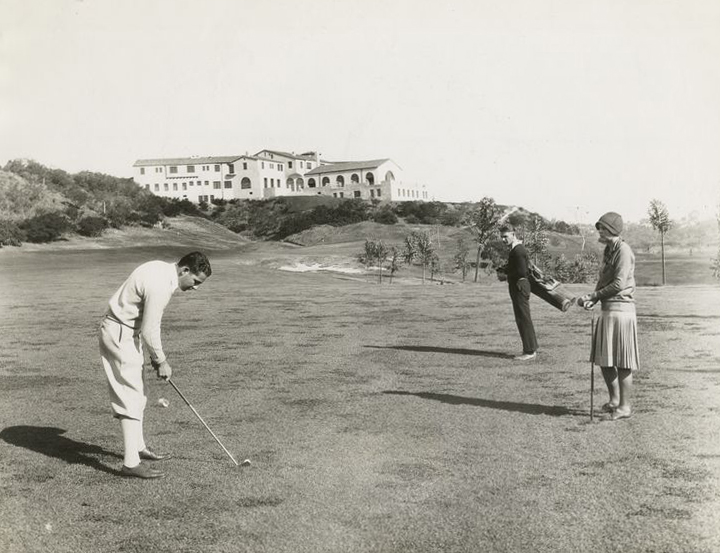
Though Riviera was built during the last few years of hickory golf, no course has opened since that better exemplifies the virtues of strategic golf. Above is the oft photographed approach to the eighteenth green.
Riviera had one key thing going for it at the start: George C. Thomas, Jr.
The property offered little; other than the high ground around the Clubhouse (for some reason it seems appropriate to capitalize this clubhouse), it was flat and enclosed by a rather abrupt valley. The soil was poor. Thomas was reluctant to accept the project and when finally convinced declared the land ‘suitable.’ William ‘Billy’ Bell, Thomas’s construction foreman here and at his other best works, and he were forced to use an array of 1920s style heavy equipment to overcome the tough going. Despite the obstacles, the result of their labors is nothing less than an architectural, strategic and construction masterpiece.
Bill Coore once remarked about his firm’s work at Sand Hills in Nebraska that they tried not to mess up the natural qualities of the property too much. By that, he meant that the site was nearly perfect and that the pressure was to build a course that matched. The opposite took place at Riviera where the natural site was merely a 5 or 6 and yet, Thomas transformed it into a 10, perhaps the greatest difference in quality between a raw site and a finished course of world class caliber. Maybe only Winged Foot had origins as unpromising as Riviera. While Thomas had distinctly superior landforms at both nearby Bel-Air and Los Angeles Country Club, Riviera is indisputably his best and one of golf’s greatest playgrounds.
Each hole at Riviera is a ‘how to’ of golf course architecture and much of the Thomas’s style can be traced to his Philadelphia roots. An aristocrat, Thomas had both the opportunity and inclination to see and study the best courses of the northeast. As a friend of both George Crump and Hugh Wilson, he was fortuitously privileged to witness the makings of Pine Valley and Merion before moving to the west coast in 1919. These influences are evident, especially Pine Valley where Crump turned the design and construction process into a real think tank of activity involving most of the era’s premiere architects. Its twelfth and thirteenth holes serve as broad inspirations for the tenth and thirteenth holes at Riviera while Thomas also embraced Pine Valley’s Sahara concept at two of his par fives, the first and eleventh.

George Thomas had as keen a grasp on strategic principles and knew how to translate them into the dirt as well as anyone in the history of golf course architecture.
Because Thomas had seen and appreciated many of the northeast’s finest designs, it is not surprising that so many classic elements are laced throughout Riviera. At the fourth we experience the first Redan built west of the Mississippi; the fifth has an Alps theme; the seventh a hog’s back fairway and the eighth features a double Lido fairway. On the inward nine we encounter a hole with Cape features at the thirteenth, Eden characteristics at the fourteenth and a Biarritz type green at the fifteenth. Thomas’ original design concepts like the extraordinary boomerang green at the first and the imaginative bunker within the sixth green are as enduring and strategic as the classically inspired features. These are examples of the nuance that elevates Riviera’s status into the stratosphere of design.
A study of the fourth hole shows how Thomas created so much quality golf out of little. Initially, the canyon wall dropped down to the floor at a steep angle. An unfazed Thomas saw an opportunity – and his construction foreman Billy Bell carried out his vision – creating a Redan hole by slowly building up an enormous green complex and tapering it off some sixty yards left and away from the canyon wall. The resulting gradual right to left slope feeding away from the canyon wall is perfect for golf and its fill provided Thomas the opportunity to create two well placed bunkers. The short right one needs to be carried to play a running draw off the hillside and have it bound onto the green which is open front right. Alternatively, the golfer who chooses a direct line toward the green must navigate the course’s largest greenside bunker, a massive expanse of sculpted sand that can leave the dreaded long explosion shot. When played into a fresh ocean breeze, a player can lay-up comfortably short of this bunker where Thomas provided plenty of fairway and hope for a pitch and putt par. On this option strewn one shotter, every golfer is free to chart his own path based on the day’s playing conditions and the state of his game.

Note how Thomas and Bell seamlessly created a gradual right to left slope to form a wide, expansive Redan green complex. A draw off the tee can be played over the right bunker and will bound onto the open green. The two crouched golfers are reading putts on the far left side of the green.
While the creation of the fourth is quite special, the most famous bit of construction occurred at the eighteenth where an enormous amount of land was moved to fill a wash and to create the majestic amphitheater which highlights the hole. Thomas carried fill down the slope and utilized it to integrate the elevated second green, third and tenth tees. The limitations of the equipment available at the time made Thomas and Bell’s undertaking an extreme feat. Yet the vast earth moving was carried out such that it is not discernible where man’s hand starts and nature’s stops. This is the highest form of both design and construction; the sort that only a handful of architects have ever achieved. Thomas and Bell did it with such panache that many players leave the course believing that the site must have been a perfect one, à la Sand Hills.
Riviera became a course that inspires passion like few others because Thomas’s profound strategic options are layered on top of superb construction. Other courses might subdue a player by sheer length or wear him down with uncompromising hazards but Riviera epitomizes a far higher, more engaging art form. Playing golf there is as consistently rewarding as any course you can name, as we see below.
Holes to Note
(Please note: all Thomas quotes below are from his Golf Architecture in America book published by The Los Angeles Times Mirror Press in 1927.)
First hole, 505/500 yards; Beyond the magic of teeing off high above the fairway in the shadow of the famed Clubhouse, the everlasting merit of the hole hinges on Thomas’s inspired boomerang green. It is much wider than deep with a bunker eating into its middle; forcing the golfer to note the hole location before driving in order to best chart his play. From the onset, the thinking golfer appreciates the alternate playing angles and understands the need to keep his wits as he will be repeatedly challenged by strategic options throughout the round.

The first tee is the highest point on the course by a good thirty feet and affords a commanding view down the length of the hole. The day’s hole location is on the far right of the green.
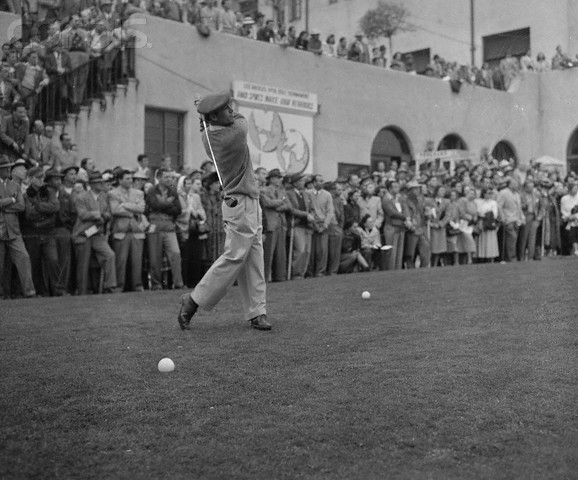
There are generally some on-lookers as one tees off, which only adds to the drama, especially if one’s swing isn’t as pressure proof as Mr. Hogan’s!

Even this view fifty yards short of the green doesn’t convey the boomerang nature of the green. However, it does show that long approach shots can chase onto the left side of the green whereas today’s right hole location beyond a depression calls for an aerial shot.
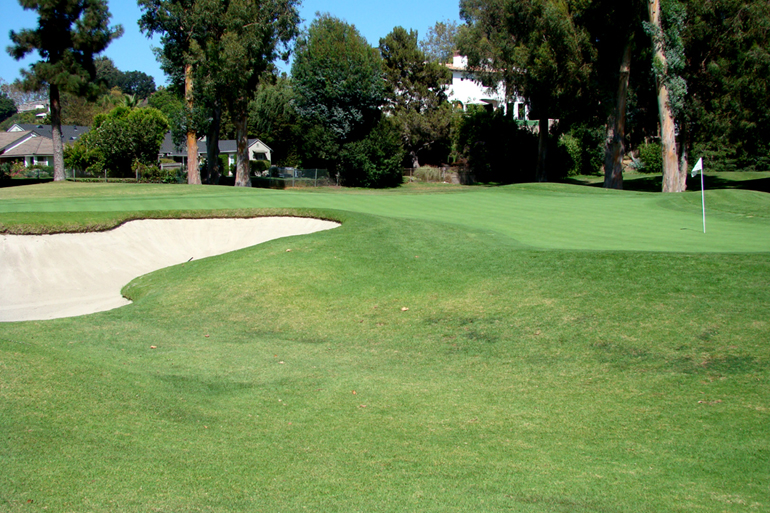
Only after playing the hole for the first time and seeing this side view does the golfer gain an appreciation of the green’s shape and playing qualities.
Second hole, 465/445 yards; Thomas wrote ‘Greens may be long and narrow, wide and shallow; in fact every shape; but the great thing to be noted is that they must adhere to three most important principles: First , their utility for the shot required, which includes correct orientation or visibility; second, their utility as to all drainage and other physical needs; third, their beauty taken as an individual unit, and also as they appear in the landscape. The man who can comply with these principles, and also diversify his greens, is a successful golf architect.’ There is no better example of this than comparing and contrasting the first two greens. As already noted, the first is much wider than deep while the second one as seen below is narrow yet deep. Like the first this is a half par hole of 4 1/2 making it a perfect foil to the opener. The only ‘weakness’ of the second nowadays is that it plays so straightforward, without the clever options of the other holes. Where is the Thomas magic? The answer lies on the hillside to the right of the green. When the course opened, much of that slope played as short grass and the golfer was able to bank his three wood hickory approach off the hillside and onto the putting surface. What a fun shot that must have been! This lost feature is an unfortunate consequence of the fame that Riviera garnered by hosting big events. The bank shot was derided by professionals as too fluky. Another design casualty was Thomas’s forty-five yard plus wide fairways. The amateur golf course architect Thomas, who never accepted a design fee for his work, certainly had a better grasp of the game’s joys than those who play it for money. It is not easy to make a 440 yard plus hole interesting but Thomas pulled it off with aplomb. Hopefully, this fun, sporty shot will one day be re-introduced into the mix.
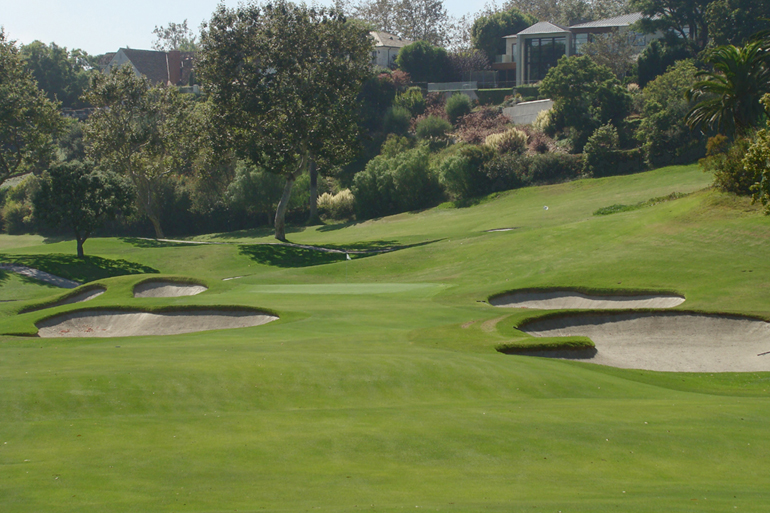
The narrow but deep second green is opposite in character to the green at the first.
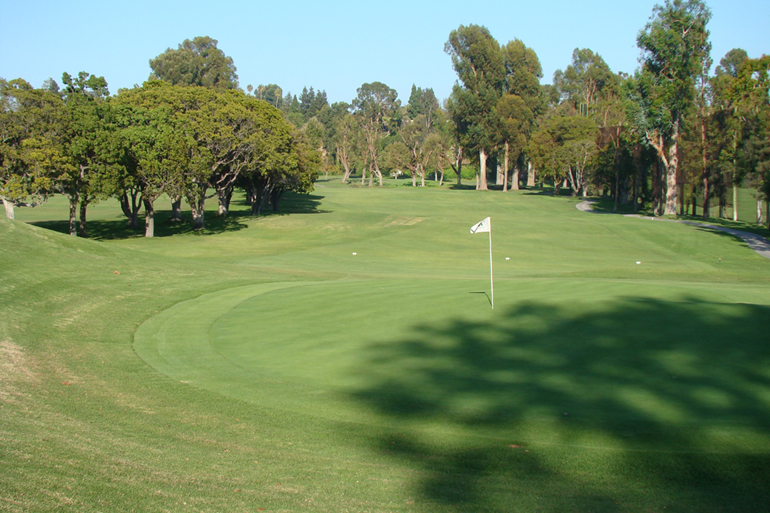
As seen from behind the second green, sticky kikuyu rough stops balls from hitting the hill to the golfer’s right of the green and bouncing onto the green. Whether that is good or bad is a matter of taste.
Third hole hole, 435/405 yards; ‘The spirit of golf is to dare a hazard, and by negotiating it reap a reward, while he who fears or declines the issue of the carry, has a longer or harder shot for this second.’ There is no better example of what Thomas meant by this than a close examination of the third hole whereby each of the three bunkers serve a distinct purpose and each complements the positions of the other two. Contrast this elegant scheme to the plethora of expensive over-bunkered modern designs and you easily understand how much more sophisticated Thomas was. Just as Pine Valley influenced Thomas, why more modern architects don’t borrow from Thomas’ design playbook at Riviera remains a mystery.

The chess match with Thomas continues at the third where the golfer dearly likes to carry past the fairway bunker to gain the optimal approach angle. Up ahead, the left bunker is quite short of the putting surface…
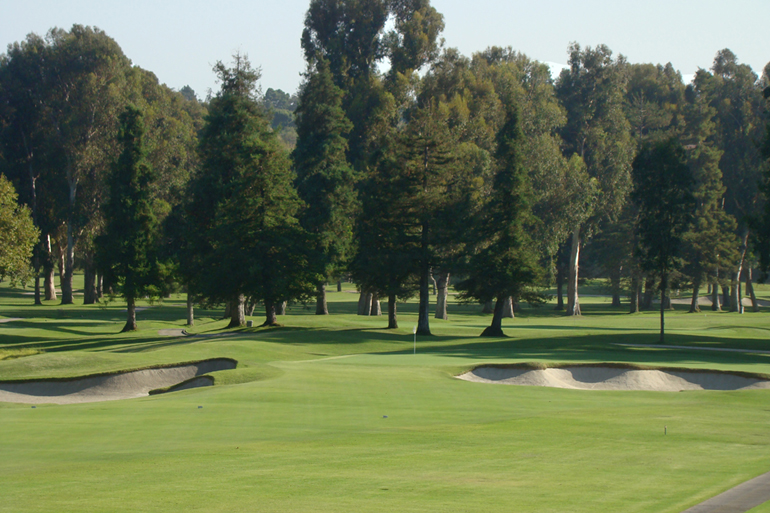
… as seen from this zoomed in view from up high. The forward left bunker and the long right bunker running diagonally along the length of the green combine to create all sorts of depth perception issues. Played downwind in a Santa Ana, gaining access to the open left portion of the green becomes particularly important.
Fourth hole, 235/225 yards; Ben Hogan is closely associated with Riviera because of his 1948 U.S. Open win and back to back LA Open victories in 1947 and 1948. The phrase ‘Hogan’s Alley’ originated here – not Colonial Country Club in Texas – after these three triumphs in a sixteen month span. A master tactician, Hogan clearly relished the strategic challenges presented by Thomas and he was able to separate himself from the field in a 72 hole stroke play event. In fact, he set a new U.S. Open scoring record at Riviera. He didn’t hide his admiration of the fourth, calling it in the LA Times the ‘greatest Par 3 hole in America.’ Played toward the ocean and frequently into the cool breeze, only a golfer like Hogan who possessed supreme ball flight control could regularly handle this defiant long one shotter.

In Golf Architecture in America and elsewhere, George Thomas was praised the talent of Billy Bell as construction foreman. Bell’s talent is most evident in the construction of the bunkers and this forty yard monster bunker that extends well back into the fairway from the fourth green is a prime example. However, many of Bell’s other contributions were just as valuable including how he seamlessly feed off the canyon wall here to produce the Redan qualities that Thomas desired.

The Redan playing characteristics are fully appreciated from this view fifty yards short and right of the fourth green.
Fifth hole, 435/410 yards; Nothing can be taken for granted on a Thomas course. Compare the fifth and twelfth holes which are found at opposite corners of the rectangular property. At the twelfth, the play off of the tee is down the left side of the fairway (nearer the out of bounds). Flirting with trouble for the sake of a reward is certainly a basis of sound golf architecture. However, variety is another cornerstone of good design, so the player should must not be able to assume anything. On the fifth, the most blatant artifice on the course takes the form of an Alps feature some fifty yards shy of the green. It cleverly obscures several right hole locations and makes for an unexpected obstacle for tee shots right of center. Ironically, the preferred route off the fifth tee is away from the out of bounds and toward the left third of the fairway. Here the wise golfer is advantaged with a superior view of the entire putting surface and afforded more level stances. Of great interest, old aerials show a clear path of drainage running down the canyon side just shy of where the mound was built. Hence, it seems reasonable to conclude that Thomas and Bell added this feature to help funnel water away from the green in a prime example of form following function.
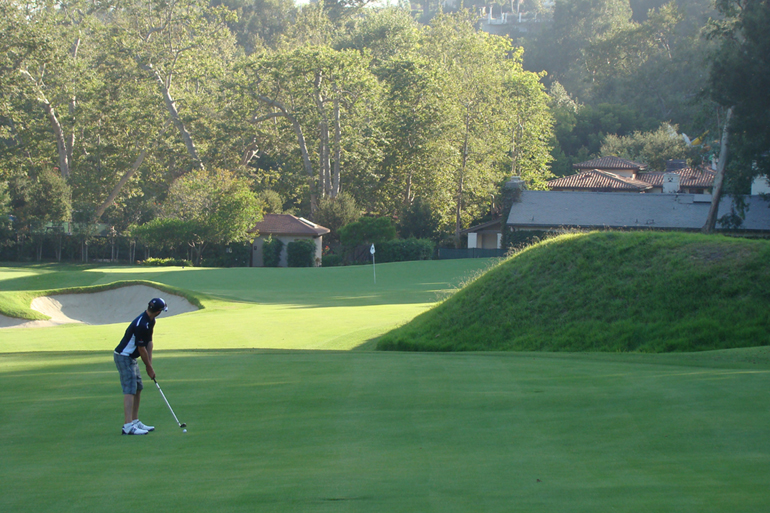
Well positioned off the tee, this golfer enjoys a fine view of the putting surface and this middle hole location. The same is not true of approach shots played farther from the right.

This view from behind the fifth green gives a sense of the drop in height from the fairway to the green. In fact, it is the only downhill approach shot on the course. Balls that carry ten yards beyond the Alps feature kick forward and left and can find the putting surface.
Sixth hole, 200/145 yards; Only an extremely confident and secure designer would dare to build such a hole. As far as the author knows, there was no precedent for a bunker encased by a putting surface. What inspired Thomas is not known but the success of the hole is assured. The green is spacious enough and contoured appropriately to accommodate such a unique hazard. The golfer has plenty of options in working his way around the green ringed pit. Right hole locations tucked into a semi-punchbowl can be surprisingly friendly but left front ones leave only troublesome second shots. In the hands of a lesser architect, the bunker might have ended up as frivolous and may not have endured. Thomas’s sense of what constitutes good golf is acutely felt here and the bunker elevates the hole from a fine hillside one shotter to an icon.

A multitude of interesting hole locations are afforded at the sixth, thanks to the slopes – and bunker – found within the green.
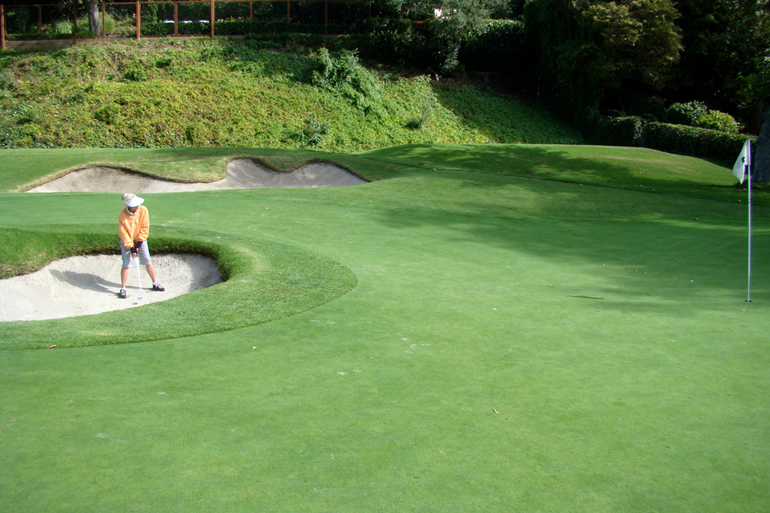
A rarity in golf is to be in the middle of a green and be left with this shot!
Seventh hole, 410/370 yards; Recently improved, the hogback fairway is once again delineated by sandscapes on the left and a wash on the right. Though difficult to force modern professionals to shape the ball these days, the tension created by the domed fairway and the long bunker certainly favors a fade as a tee ball that is drawn can catch the fairway contour and scamper into the bunker. Perhaps the most underestimated hole on the course.

No reason to flirt with the barranca down the right of the fairway …
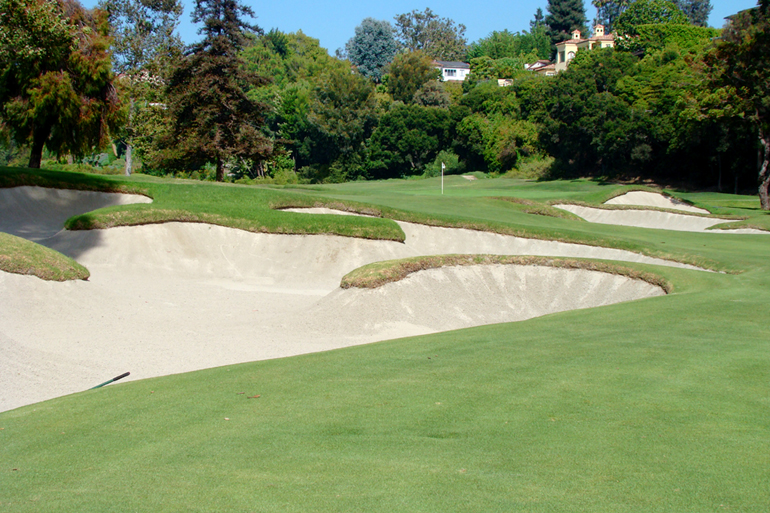
… as the best angle into the green is afforded from near the left fairway bunker. Note how the entire putting surface is visible.

The tiny 3,300 square foot knob of a green leaves many ticklish recovery shots.
Eighth hole, 435/375 yards; Riviera hired Fazio Golf Course Designers as consulting architects in 1999. Shortly thereafter, the club sought their guidance in restoring Thomas’s alternate (right) fairway as the hole at the time only played to a single (left) fairway. Ever since, the hole has been a work in progress. Though not perfect in its present form, the eighth is better than at any point since World War II. Might the raves about the recent successful restoration on Thomas’s North Course at Los Angeles Country Club stimulate Riviera to present the barranca so that it looks like part of southern California rather than Scottsdale and also reconstruct the green in a manner consistent with a Thomas design.

A decade ago, the eighth was tightly tree lined and featured only the left fairway. The golfer today needs to decide whether to play for the right island for the purpose of a level stance and better angle into the green or go left off the tee for the sake of not having to cross the hazard again on one’s approach. Unfortunately, the large, relatively flat green doesn’t quite do the job in providing enough hole locations whereby the preferred path alternates from one day to the next.

The left fairway still features some of the boldest fairway contours that Thomas incorporated into Riviera.
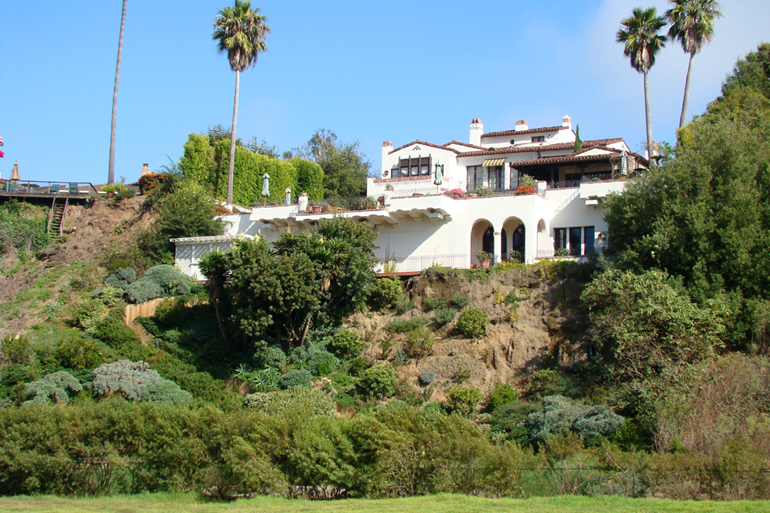
Apart from the opening tee ball, the golf at Riviera is played in its own secluded canyon. Mansions like this one that features a thirteen car garage (!) dot the rim of the canyon, well removed from play.
Ninth hole, 460/405 yards,; Sandwiched between two iconic par fours, this robust two shotter is of no less a design standard. Max Behr, who moved to California from the east coast one year before Thomas, wrote, ‘The purpose of golf architecture is to give an intelligent purpose to the striking of the golf ball.’ This hole perfectly captures the essence of that noble sentiment. A short right bunker must be carried off the tee to best reveal the green which Thomas angled 45 degrees to the fairway. With a putting surface running swiftly from back to front, the hole’s challenge spins around placing one’s approach shot below the hole. First time golfers rarely realize just how uphill the second shot plays and regularly fail to add the one or two clubs necessary. Most courses that have an imposing elevated clubhouse suffer weak uphill returning holes. Both nines return at Riviera and both the in and out nine closers are superb, another special characteristic of this Thomas gem. While the approach to the Home green is more famous, this one is arguably more demanding given the uncompromising nature of its narrow tilted green. Often the PGA Tour’s best run downhill putts 10 and 12 feet past front hole locations.
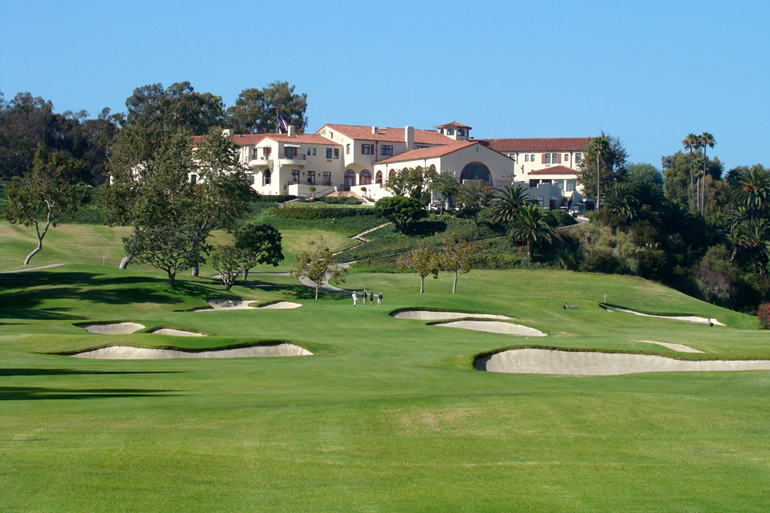
Thomas’s short right and long left bunkering pattern and the dominant clubhouse position fool the golfer into underestimating just how much uphill the ninth plays.
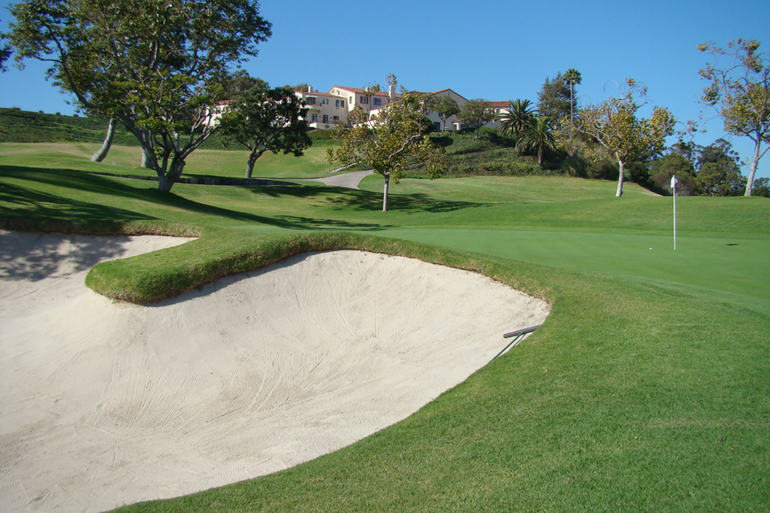
The narrow, angled green itself is overshadowed by Thomas/Bell’s bunkering but its steep back to front pitch provides several of the hardest hole locations on the course.
Tenth hole, 315/300 yards; The pinnacle of golf course architecture may well be this hole. You don’t have to be a genius like Thomas to figure out what hole was fresh in his mind as he penned these words: ‘By reducing the size of the green, by tilting it up from one side to the other, or back or front, so as to require a placement on the drive for a shot which can be played toward the higher part, by making it narrow and long with the opening opposite the carrying trap, it is easy to insist on a fine shot to make the second one reasonably possible.’ Like the eighteenth at Pebble Beach, the tenth has benefited from advances in technology. Today, the distance makes it so tempting, so beguiling that many more tiger golfers have a go at the green. Indeed, 72% went for the green over four days during the 2008 Nissan Open. Some even gear down to a three wood because the left front edge is ‘only’ 295 yards from the tee. This bewitching option creates great drama. While the hole might be driven and eagle putts holed, the failed tee shot is often very much out of position. Only 4% who attempted to do so reached the green leaving 96% with some sort of a recovery shot. A hole without peer, the tenth’s strategy is crystallized by the angle of the green’s spine relative to the tee and the narrow putting surface which slopes away. Golfers lured into going directly for the flag are almost always thwarted by this devilish combination. The golfer who plays left and well away from the green gains the best angle down the length of the green making its tilt less problematic. Knowledgeable men gasp in the horror at tee shots flared/missed to the right, such is the negative bias that Thomas created from over there. A tip of the hat to George Crump and his twelfth hole at Pine Valley with its runaway green perpendicular to the tee is deserved in helping Thomas formulate this hole of outstanding merit.
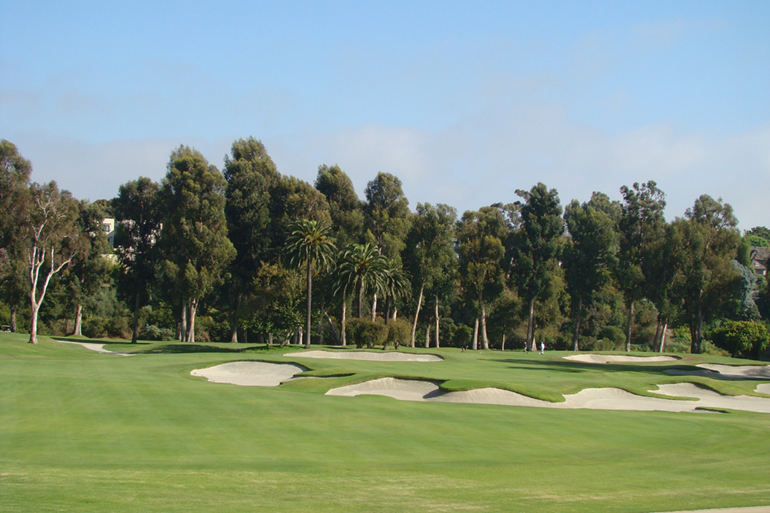
The famous view from the tee shows two golfers on the tantalizingly close tenth green. The large bunker in the
foreground is actually one of the less important elements to the hole.

The prudent play from the tee is toward the outside left of the fairway from where the golfer is left with this reasonable approach angle down the length of the tenth green.
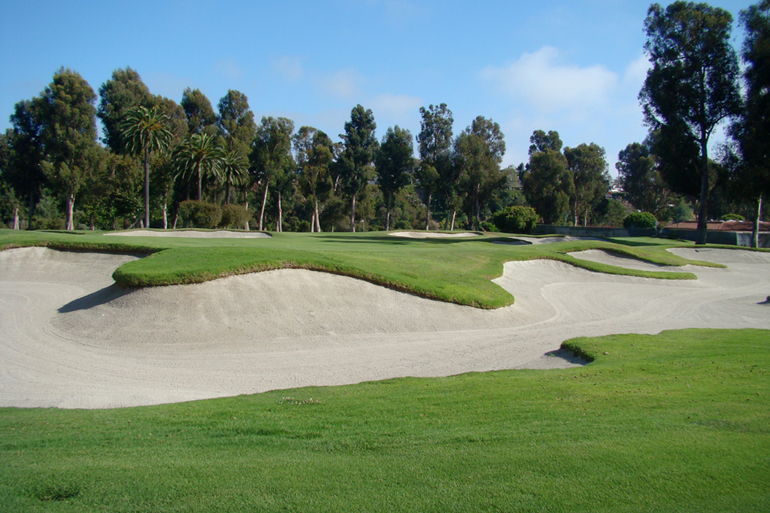
Any approach from right of fairway center leaves a miserable angle.
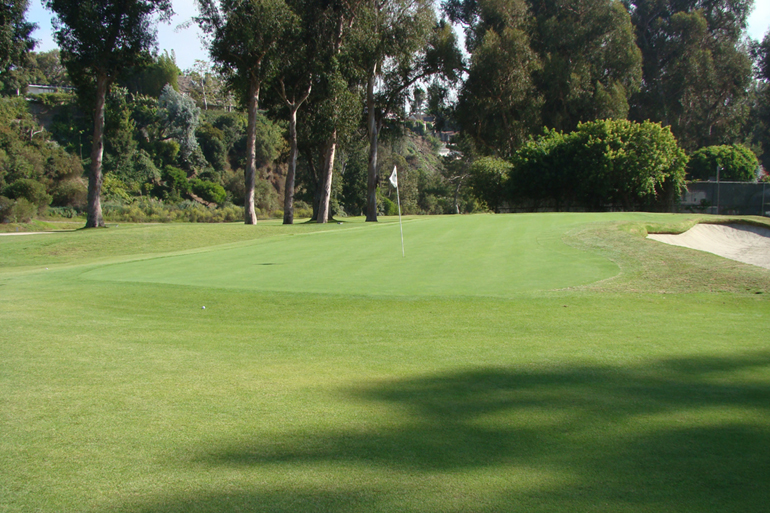
Despite the flashy bunkers, it is the menacing, slender green that wreaks the most havoc.

This view from behind the tenth green highlights just how narrow the green is, pinching in at one point to just nine paces.
Eleventh hole, 565/515 yards; Since no two holes play remotely alike at Riviera, collectively the eighteen pose an almost unmatched array of challenges. For example, the tenth features the most heavily bunkered fairway on the course and is followed by three holes without a single fairway bunker to confront the tee shot. While the eleventh, fairway and green are laid across flat ground, Thomas placed the long fairway on either side of a 67 yard wide barranca that crosses 160 yards from the green. Hit a good drive and the green may be reached in two but a lesser strike makes the barranca the problematic carry it has been for the last eight decades.
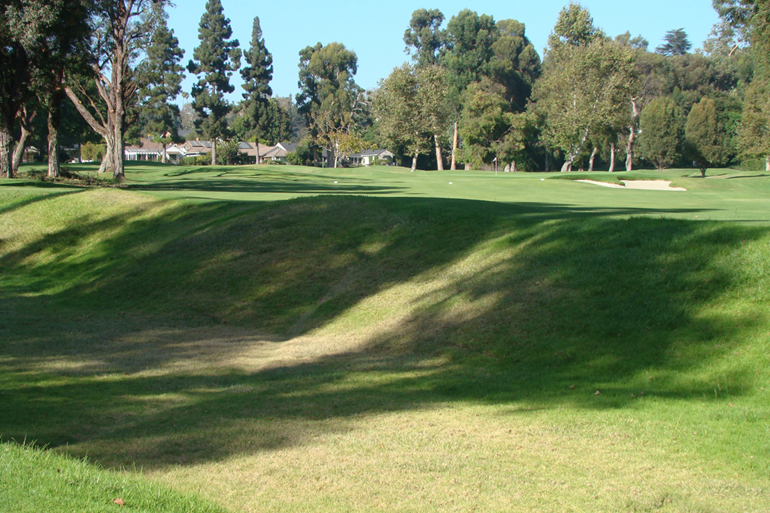
In order to carry this barranca on one’s second, the player must find the fairway off the eleventh tee.
Twelfth hole, 480/365 yards; Full of ideas, Thomas didn’t utilize water or other artificial gimmicks as a design crutch. What natural features existed at Riviera are exploited for uncommon variety and interest. Here he built a medium length two shooter and employed the barranca in the most confrontational manner possible, blocking off access to the green from any low punch shot along the ground. In so doing, a suitable reward is had by placing one’s tee ball in the fairway. Getting more precise, finding the fairway’s left center is even better as one’s approach then slots nicely between the one man-made hazard on the hole and a stately sycamore tree.
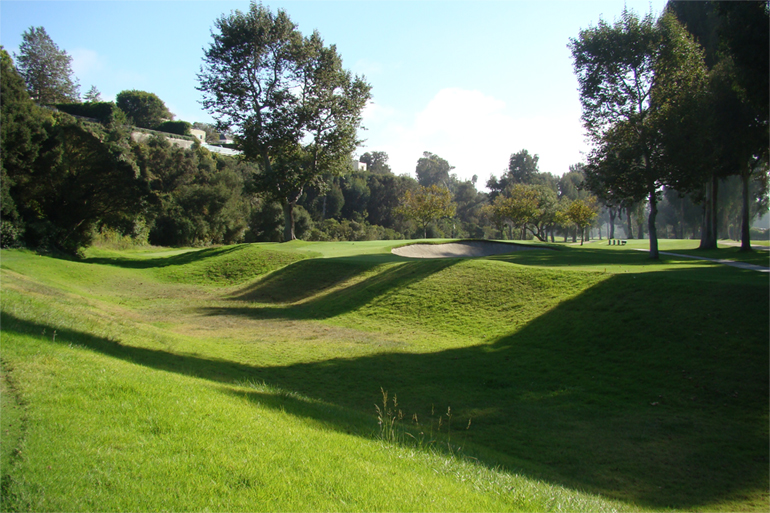
The well situated twelfth green with a deep bunker right and Humphrey Bogart’s tree to the left.
Thirteenth hole, 460/405 yards; Opened for play two years before the Great Depression, Riviera belongs on the short list of top courses that emerged from the Golden Age of Architecture. However, unlike other paragons of designs like Cypress Point, Merion, Oakmont, and National Golf Links of America, several of Riviera’s playing features still want for attention. The most glaring example is now found here, given how the eighth has been approved upon in the past decade. In Thomas’s day, the thirteenth played as a Cape; the closer the golfer hugged the barranca off the tee, the more advantage he gained on his approach into a green which protruded into the same hazard. After several severe floods, the club sheltered the thirteenth fairway by growing a grove of eucalyptus trees between the barranca and the fairway. The hole’s uniqueness – and its playing options – have suffered. Removing those trees on the inside of this hole which swings right to left would not be difficult or expensive but the impact on strategic play would be enormous. Thomas’s acknowledged inspiration here was the mighty thirteenth at Pine Valley which is generally considered among the game’s dozen finest two shot holes. It would be special indeed to recapture such grand magic!

Thomas swung the thirteenth fairway left along a barranca. Every tree between the fairway and the barranca should be felled.

Though a long hole, the thirteenth features just one bunker and it is fifty yards short of the green, protecting the high side of the green. The barranca is a mere dozen paces from the back left edge of the green. Rather than flirt with it, the golfer is better served to use the right to left slope of the ground to work balls close to such hole locations.
Fourteenth hole, 175/160 yards; A fine one shotter, the only shortcoming is that the fourteenth doesn’t measure up to the exceptional standard of the other one shotters. Nonetheless, the time honored concept of bunkers left and right and a back to front sloping green as perfected by the Eden at The Old Course at St. Andrews is well executed here. At over 6,500 square feet, this green is surprisingly among the three largest on the course and facilitates three putt bogies with alarming regularity. While Thomas served in World War I, it is unclear to this author how much time, if any, Thomas spent studying the great courses in the United Kingdom. His writing is mum on this point so perhaps his sources of inspiration were from those who had been there and their subsequent work in the United States.
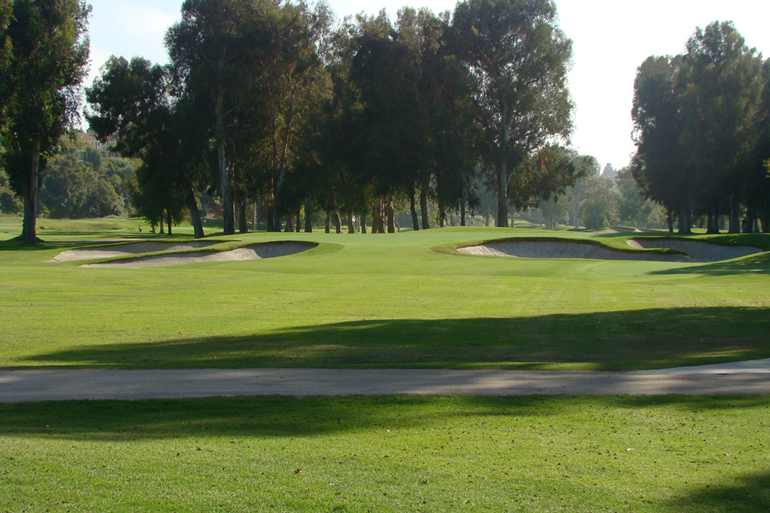
The trees behind the wide but shallow green make judging the wind a tricky proposition. Putts from the center of the green
toward left hole locations are particularly problematic as they are more downhill than the golfer may realize.
Fifteenth hole, 485/430 yards; One of the surest ways to assess the talent of an architect is to study how he handles flat, featureless land. The high to low point on what became the fifteenth hole was a mere three feet and there were no barrancas or other natural feature on this interior part of the property. What did Thomas do? He moved dirt so that it mattered. Bell created a wide bunker on the inside of this dogleg that grabs the golfer’s respect and its dominant location makes the hole play its full distance. The only other dirt moved was in the creation of the imaginative green complex and minimally raised tee. Once again, Thomas shows us how less can be more.
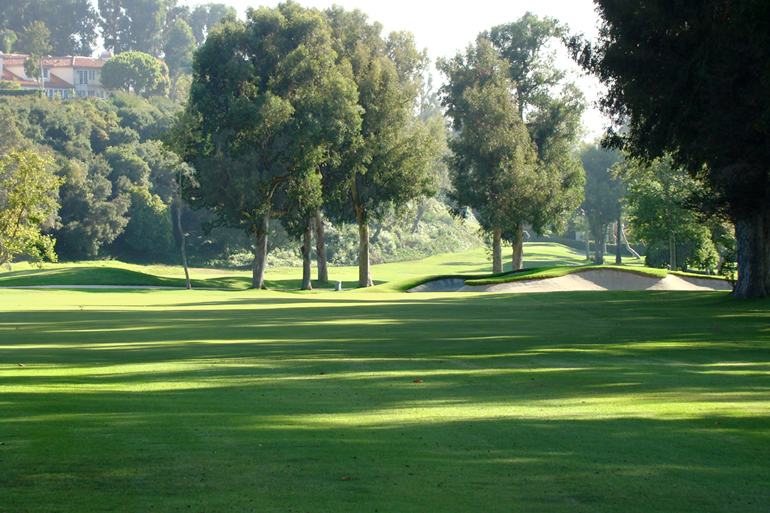
As seen from the tee, the bunker serves as a how to lesson in bunkering the inside of a dogleg.
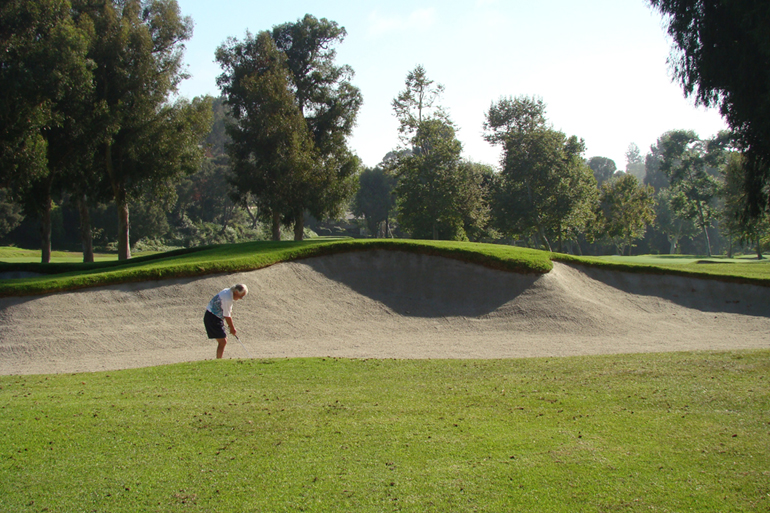
Left with no hope and a 200 yard shot to the green, the gentleman above will testify that the deep fairway bunker is no place to miss one’s tee ball. The white flag and green can be seen above the right edge of the bunker.

Note how the creative green is high front left, dips in the middle and then rises again in the back right.
Sixteenth hole, 165/150 yards; Both nines are rife with memorable holes with the back playing harder relative to par despite having two of the course’s three par fives. The reason is that its two shorter holes (here and the tenth) are wickedly adept at enticng the golfer into woeful positions from which his score will suffer. Short siding oneself in a deep greenside bunker here often leads to numbers in excess of par. Another perilous foible is getting above the hole on this fiercely sloped back right to front left green. Often enough a first putt from above the hole is struck with fear and a furrowed brow, the next one is hit with a mixed sense of desperation and false hope, while the third is clanked with grim resignation. Thomas could well have been writing about the wickedly sloped green when he wrote, ‘The strategy of golf is the thing which gives the short accurate player a chance with a longer hitter who cannot control his direction or distance. It is the factor which permits the brilliant putter the opportunity of recovery; but flat greens, or greens with only slight roll, do not supply this interest, for on such nearly everyone is able, as a rule, to go down in two putts, or to hole reasonably long ones.’
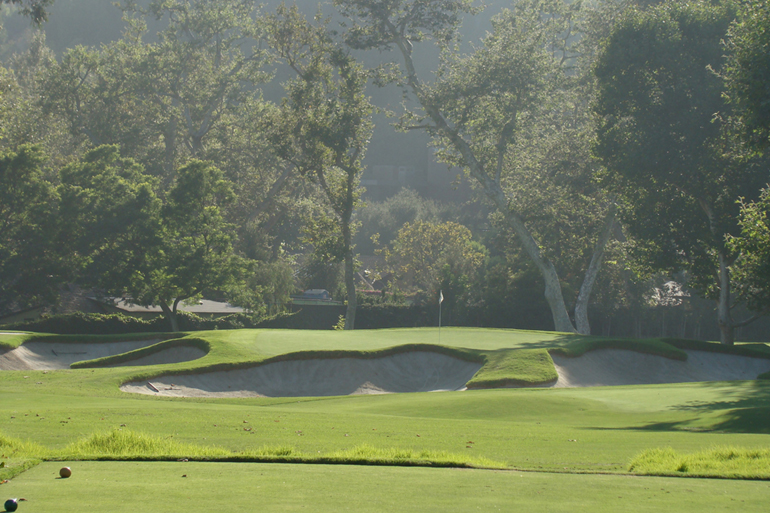
Though the sycamore trees and bunkers steal the show, the sharply pitched green from back right to front left is what gives fits to better golfers.
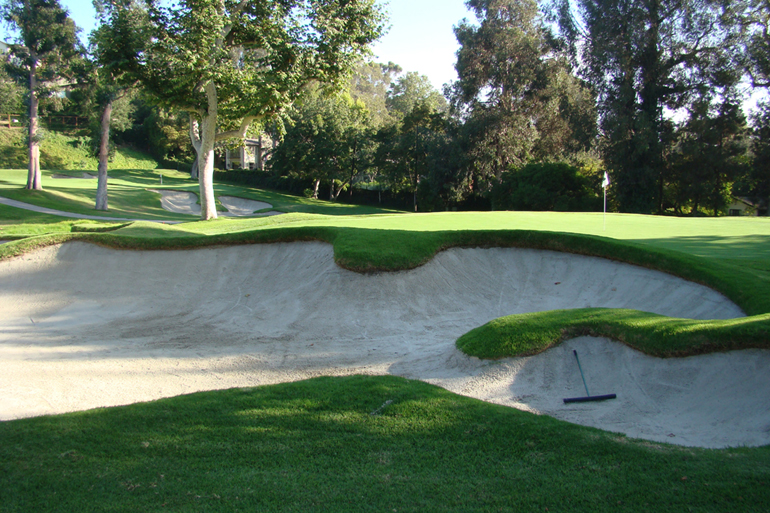
This front bunker provides many testing recovery shots to the small sloping green.
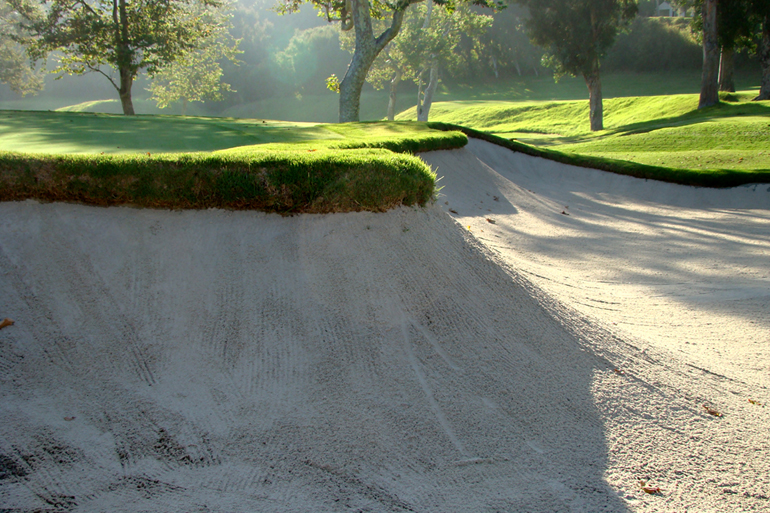
As seen at the sixteenth, the bunkers at Riviera are things of great beauty. Not as originally built by Bell whose bunkers were shallower with more jagged edges, they have evolved over time with high splash faces to become some of the most famous looking bunkers in the world.
Seventeenth hole, 590/510 yards; Pebble Beach and Riviera have been professional golf’s standard bearer for par more so than other courses west of the Rockies. Riviera was constructed during the final few years of hickory clubs, and endured the staggering advances of technology. As a defense, Riviera has but three par fives for the professionals to beat up on. The last is here, the penultimate hole and it plays the longest as it meanders up a gradual slope from a tee near the canyon’s low point . Of all the work Tom Marzolf has undertaken on behalf of the Fazio organization, his best is likely here. If a par five is to withstand the onslaught of technology, it must be well defended at the green. Curiously, that was never the strength of the seventeenth as designed by Thomas. The long right greenside bunker was originally built a good eight paces away from the putting surface. Why? No one knows! The best guess is that it was done so to create variety from the tightly bunkered sixteenth. But still … in today’s age, the seventeenth didn’t measure up to the other holes. The smart alterations here help the last four holes rank among the game’s dozen or so finest closing stretches.
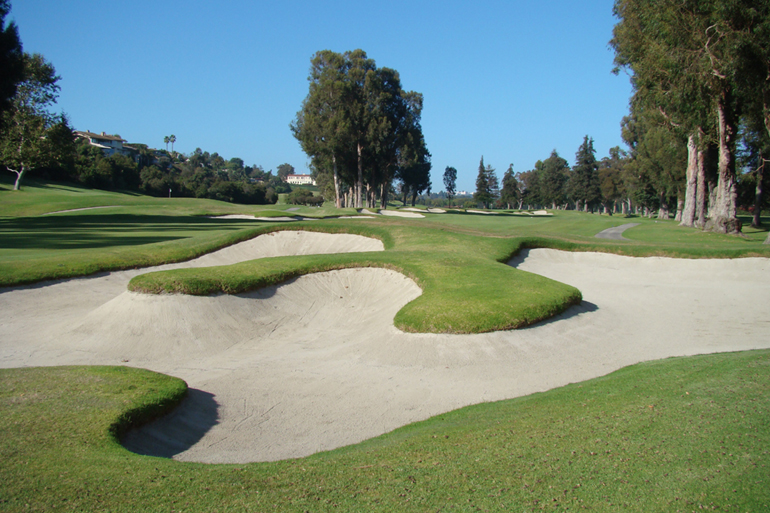
The seventeenth is the most heavily bunkered hole on the course and it is paramount to avoid this gaping bunker to the right of the fairway off the tee.
 The echelon bunkers guarding the seventeenth green greatly add to the hole’s playing qualities as the third shot is now properly exacting.
The echelon bunkers guarding the seventeenth green greatly add to the hole’s playing qualities as the third shot is now properly exacting.
Eighteenth hole, 475/420 yards; Given how the first hole descends into the canyon, and how the first seventeen holes play in it, there logically comes a point where the golfer must come up and out of it. That occurs in two ways. First, the tee ball at the eighteenth must climb a steep sixty foot tall embankment to find the fairway. On top, the task while clear is daunting for the golfer without a power fade as reliable as Hogan’s. After holing out the golfer is still well below the Clubhouse but Thomas sensibly had the player finish the climb out of the canyon via a flight of stairs behind the green. Standing on the rim of the canyon, one is sure to steal one last admiring look down onto the course where so much great golf is had.
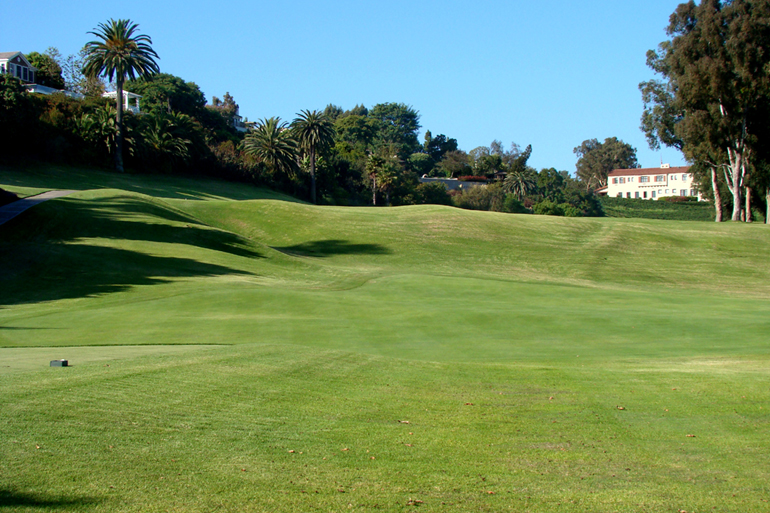
Given how this is the Home hole, and given how the eighteenth tee is on the canyon floor, the golfer shouldn’t be surprised to find the abrupt rise to reach the eighteenth fairway.
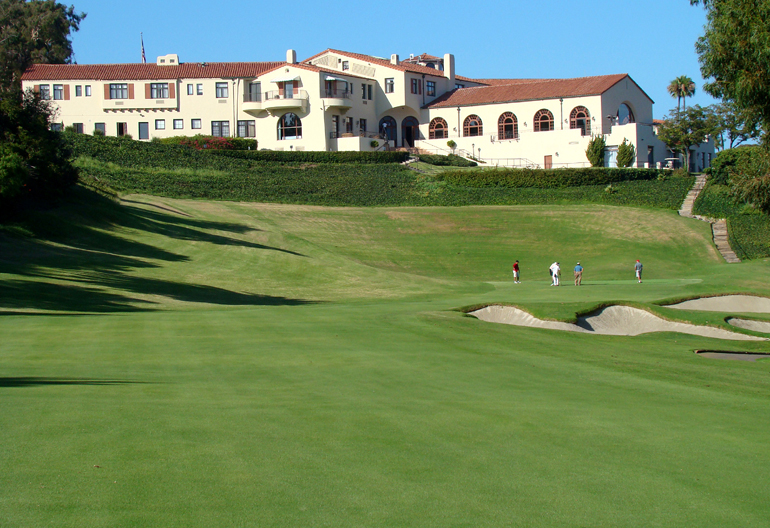
No more famous approach shot exists in American golf to a Home green than this one at Riviera. The golfer can’t help but think of all the greats that have gone before him as he approaches the green. As good as the hole is, it might not even be among the course’s five or six best which tells you all you need to know!
Tracing the development and spread of golf course architecture is fascinating. Its primordial origins are found among the dunes along the North Sea. It was honed into an art form on the great heaths around London. It migrated across the Atlantic after Americans like Macdonald, Fownes, Crump and Wilson traveled to the United Kingdom and studied the great British venues understanding their design strategies. Their subsequent creations on the east coast of the United States set new standard: National Golf Links of America, Oakmont, Pine Valley and Merion. Men like George Thomas took note and brought these traditions to the west establishing levels of architecture as compelling as the best found along the North Sea, the heathlands or the east coast.
What a time the 1920s were in California! Just as many of the great architectural minds were centered around Woking in the 1900s and in Philadelpia/New York in the 1910s, so too did they congregate in California in the 1920s. Max Behr, Alister MacKenzie, Robert Hunter, Chandler Egan, Billy Bell, Norman Macbeth, Willie Watson and George Thomas constituted a most formidable intellectual group and they produced some of the finest written words on the subject of golf architecture. Thomas’s friend Max Behr wrote eloquently about the need of addressing a present problem for the sake of addressing a future liability and no series of holes better encapsulates that design belief than Riviera.
Los Angeles is nearly 10,000 miles from the heaths of London which provided the first canvases upon which men created intelligent golf design. Those accomplishments heralded the beginning of golf course architecture and the design strategies that have provided golfers with so much challenge and enjoyment. George Thomas’ foray into the geographically diverse environs of the city of Angels and his construction there are no less an accomplishment and no less a standard setter than those Londoners. His golf courses are sophisticated, innovative and in synch with nature. They should be appreciated, studied and above all preserved and enhanced. The Japanese are the current custodians of Riviera having taken ownership about 25 years ago. They have invested significantly in the club and its infrastructure. Hopefully their future efforts will be enlightened and they will seek ways to get Thomas’ masterpiece restored so that the intricate detailing of his genius fully reappears.

